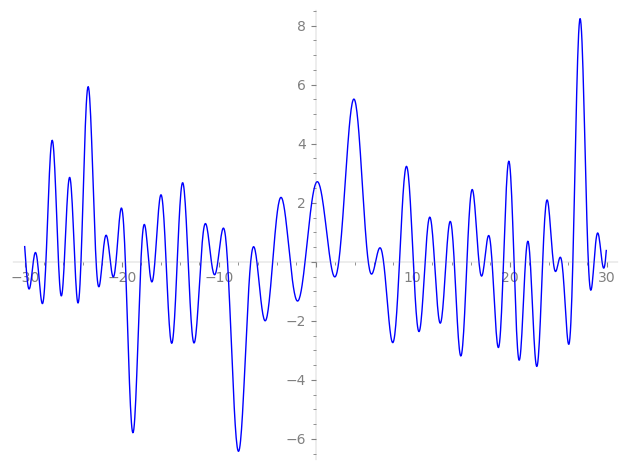| L(s) = 1 | − 4.24i·2-s + (−28.7 + 36.9i)3-s + 109.·4-s + 462.·5-s + (156. + 121. i)6-s − 525. i·7-s − 1.01e3i·8-s + (−539. − 2.11e3i)9-s − 1.96e3i·10-s + 3.34e3·11-s + (−3.15e3 + 4.05e3i)12-s + 132.·13-s − 2.23e3·14-s + (−1.32e4 + 1.70e4i)15-s + 9.78e3·16-s − 2.13e4·17-s + ⋯ |
| L(s) = 1 | − 0.375i·2-s + (−0.613 + 0.789i)3-s + 0.859·4-s + 1.65·5-s + (0.296 + 0.230i)6-s − 0.579i·7-s − 0.697i·8-s + (−0.246 − 0.969i)9-s − 0.621i·10-s + 0.758·11-s + (−0.527 + 0.678i)12-s + 0.0167·13-s − 0.217·14-s + (−1.01 + 1.30i)15-s + 0.597·16-s − 1.05·17-s + ⋯ |
\[\begin{aligned}\Lambda(s)=\mathstrut & 69 ^{s/2} \, \Gamma_{\C}(s) \, L(s)\cr =\mathstrut & (0.890 + 0.454i)\, \overline{\Lambda}(8-s) \end{aligned}\]
\[\begin{aligned}\Lambda(s)=\mathstrut & 69 ^{s/2} \, \Gamma_{\C}(s+7/2) \, L(s)\cr =\mathstrut & (0.890 + 0.454i)\, \overline{\Lambda}(1-s) \end{aligned}\]
Particular Values
| \(L(4)\) |
\(\approx\) |
\(2.58142 - 0.620377i\) |
| \(L(\frac12)\) |
\(\approx\) |
\(2.58142 - 0.620377i\) |
| \(L(\frac{9}{2})\) |
|
not available |
| \(L(1)\) |
|
not available |
\(L(s) = \displaystyle \prod_{p} F_p(p^{-s})^{-1} \)
| $p$ | $F_p(T)$ |
|---|
| bad | 3 | \( 1 + (28.7 - 36.9i)T \) |
| 23 | \( 1 + (1.09e4 + 5.73e4i)T \) |
| good | 2 | \( 1 + 4.24iT - 128T^{2} \) |
| 5 | \( 1 - 462.T + 7.81e4T^{2} \) |
| 7 | \( 1 + 525. iT - 8.23e5T^{2} \) |
| 11 | \( 1 - 3.34e3T + 1.94e7T^{2} \) |
| 13 | \( 1 - 132.T + 6.27e7T^{2} \) |
| 17 | \( 1 + 2.13e4T + 4.10e8T^{2} \) |
| 19 | \( 1 + 1.51e4iT - 8.93e8T^{2} \) |
| 29 | \( 1 + 4.05e4iT - 1.72e10T^{2} \) |
| 31 | \( 1 - 2.04e5T + 2.75e10T^{2} \) |
| 37 | \( 1 - 1.85e5iT - 9.49e10T^{2} \) |
| 41 | \( 1 + 4.85e5iT - 1.94e11T^{2} \) |
| 43 | \( 1 - 9.86e5iT - 2.71e11T^{2} \) |
| 47 | \( 1 - 5.53e5iT - 5.06e11T^{2} \) |
| 53 | \( 1 - 4.68e5T + 1.17e12T^{2} \) |
| 59 | \( 1 - 1.76e6iT - 2.48e12T^{2} \) |
| 61 | \( 1 - 1.52e6iT - 3.14e12T^{2} \) |
| 67 | \( 1 + 3.43e6iT - 6.06e12T^{2} \) |
| 71 | \( 1 - 6.49e5iT - 9.09e12T^{2} \) |
| 73 | \( 1 + 3.55e6T + 1.10e13T^{2} \) |
| 79 | \( 1 + 2.78e6iT - 1.92e13T^{2} \) |
| 83 | \( 1 - 1.42e6T + 2.71e13T^{2} \) |
| 89 | \( 1 + 1.04e7T + 4.42e13T^{2} \) |
| 97 | \( 1 - 1.03e7iT - 8.07e13T^{2} \) |
| show more | |
| show less | |
\(L(s) = \displaystyle\prod_p \ \prod_{j=1}^{2} (1 - \alpha_{j,p}\, p^{-s})^{-1}\)
Imaginary part of the first few zeros on the critical line
−13.14766098135790567459079613792, −11.84544031255628062442891518989, −10.75392554841187233113853448816, −10.09308236325362665876004055611, −9.091851364751396438491646331056, −6.70306922735343615833586171972, −6.06589727651428592672585947051, −4.43590218465990095454243510135, −2.61957346441150490109906648398, −1.10057566666238752169523407296,
1.52334071943799096739746190292, 2.37371423625134880781008156346, 5.41720026647515843651966312659, 6.17183320544105764175248562315, 6.99144354217591967491168778376, 8.635037127368859541234508515689, 10.06206521876252565507784837045, 11.27561537414447528440686033857, 12.24362434875273767072788778862, 13.42653412556686188678359394414

